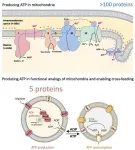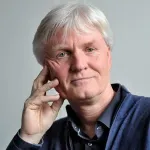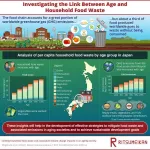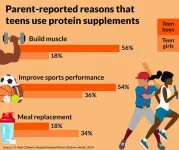(Press-News.org) It is one of the most fundamental questions in science: how can lifeless molecules come together to form a living cell? Bert Poolman, Professor of Biochemistry at the University of Groningen, has been working on this problem for over twenty years. He aims to understand life by trying to reconstruct it; he is building simplified artificial versions of biological systems that can be used as components for a synthetic cell. Poolman recently published two papers in Nature Nanotechnology and Nature Communications. In the first paper, he describes a system for energy conversion and cross-feeding of products of this reaction between synthetic cells, while he describes a system for concentrating and converting nutrients in cells in the second paper.
Six Dutch research institutes are collaborating in the consortium BaSyc (Building a Synthetic Cell) to build the elements needed for a synthetic cell. Poolman’s group has been working on energy conversion. The real-life equivalents he aims to replicate are mitochondria, the ‘energy factories’ of the cell. These use the molecule ADP to produce ATP, which is the standard ‘fuel’ that cells require to function. When ATP is converted back into ADP, the energy is released and used to drive other processes.
Artificial energy factories
‘Instead of the hundreds of components of mitochondria, our system for energy conversion uses just five,’ says Poolman. ‘We set out to simplify it as much as possible.’ This may sound odd, as evolution has done a great job of producing functional systems. ‘However, evolution is a one-way street, it builds on existing components and this often makes the outcome very complex,’ explains Poolman. An artificial replica, on the other hand, can be designed with a specific outcome in mind.
The five components were placed inside vesicles, tiny cell-like sacs, that can absorb ADP as well as the amino acid arginine from the surrounding fluid. The arginine is ‘burned’ (deaminated) and thus provides the energy to produce ATP, which is secreted from the vesicle. ‘Of course, the simplification comes at a price: we can only use arginine as the energy source, while cells use all kinds of different molecules, such as amino acids, fats, and sugars.’
Next, the Poolman group designed a second vesicle that is able to absorb the secreted ATP and use it to drive an energy-consuming reaction. The energy is provided by turning ATP back into ADP, which is then secreted and can be absorbed by the first vesicle, closing the loop. Such a cycle of ATP production and use is the foundation of metabolism in every living cell and drives the ‘machinery’ for energy-consuming reactions such as growth, cell division, protein synthesis, DNA replication, and more.
An artificial pumping system
The second module that Poolman created was a bit different: a vesicle in which a chemical process causes the interior to build up a negative charge and, in doing so, form an electrical potential, similar to that of an electronic circuit. The electrical potential is used to couple charge movement to the accumulation of nutrients inside the vesicle, which is carried out by transporters. These proteins in the membrane of the vesicle work a bit like a water wheel: positively charged protons ‘flow’ through it from outside the vesicle to the negatively charged interior. This flow drives the transporter, which in this case imports a sugar molecule, lactose. Again, this is a very common process in living cells, requiring many components that Poolman and his team mimicked with just two components.
When he submitted a paper describing this system, a reviewer asked if he couldn’t do something with the lactose that is being transported, as cells use nutrients like this to produce useful building blocks. Poolman took up the challenge and added three more enzymes to the system, which oxidized the sugar and enabled production of the coenzyme NADH. ‘This helper molecule plays an essential role in the proper functioning of all cells,’ explains Poolman. ‘And by adding NADH production, we have shown that it is feasible to expand the system.’
But what about the synthetic cell?
Having a simplified synthetic equivalent of two key features of life is fascinating, but many more steps need to be integrated to form an autonomously growing and dividing synthetic cell. ‘The next step we want to take is adding our metabolic energy producing systems to a synthetic cell division system created by colleagues,’ says Poolman.
The BaSyc programme is entering its final years; funding for a new programme has recently been secured. A large consortium of Dutch groups, in which Poolman is one of the leading scientists, received 40 million euros to create life from non-living modules. This EVOLF project is set to run for another ten years and aims to find out how many more lifeless modules can come together and create living cells. ‘Ultimately, this would give us a blueprint for life, something that is currently lacking in biology,’ concludes Poolman. ‘This may eventually have all kinds of applications, but will also help us to better understand what life is.’
References:
Miyer F. Patiño-Ruiz, Zaid Ramdhan Anshari, Bauke Gaastra, Dirk J. Slotboom & Bert Poolman: Chemiosmotic nutrient transport in synthetic cells powered by electrogenic antiport coupled to decarboxylation . Nature Communications, 12 September 2024
Laura Heinen, Marco van den Noort, Martin S. King, Edmund R.S. Kunji and Bert Poolman: Synthetic syntrophy: Synthetic syntrophy for adenine nucleotide cross-feeding between metabolically active nanoreactors . Nature Nanotechnology 21 October 2024
END
Creating a simplified form of life
Scientists build modules for synthetic cellU
2024-10-21
ELSE PRESS RELEASES FROM THIS DATE:
Large-scale study of brain volume finds genetic links to Parkinson’s disease and ADHD
2024-10-21
In one of the largest-ever studies of DNA and brain volume, researchers have identified 254 genetic variants that shape key structures in the “deep brain,” including those that control memory, motor skills, addictive behaviors and more. The findings were just published in the journal Nature Genetics.
The study is powered by the Enhancing Neuro Imaging Genetics through Meta-Analysis (ENIGMA) consortium, an international effort based at the Keck School of Medicine of USC, which unites more than 1,000 research labs across 45 countries to hunt for genetic variations that affect the brain’s structure and function.
“A lot of brain diseases are known to be partially ...
Understanding the relationship between food waste, climate change, and aging population
2024-10-21
Food production is one of the pillars of human civilization and underlies many of the changes caused by humans on planet’s landscapes. Producing food and getting it to people’s plates entails a significant expenditure of energy and resources. Unfortunately, approximately one third of all food produced globally is not consumed and discarded. Hence, to build sustainable societies, it is essential to minimize food waste.
In Japan, based on estimates reported by governmental institutions, an astonishing 2.47 megatons of food waste was generated in ...
Can aerobic exercise help prevent brain fog caused by chemotherapy?
2024-10-21
Many women who receive chemotherapy experience a decreased ability to remember, concentrate, and/or think—commonly referred to as “chemo-brain” or “brain fog”—both short- and long-term. In a recent clinical trial of women initiating chemotherapy for breast cancer, those who simultaneously started an aerobic exercise program self-reported greater improvements in cognitive function and quality of life compared with those receiving standard care. The findings are published by Wiley online in CANCER, a peer-reviewed journal of the American Cancer Society.
The study, called the Aerobic exercise and ...
National poll: Many teens use protein supplements for muscle growth, sports performance
2024-10-21
ANN ARBOR, Mich. – Protein bars, shakes and powders are increasingly popular among adults – but many teens may be jumping on the bandwagon too.
Two in five parents say their teen consumed protein supplements in the past year, according to the University of Michigan Health C.S. Mott Children’s Hospital National Poll on Children’s Health. The trend was more common among teen boys who were also more likely to take protein supplements every day or most days, parents reported.
“Protein is part of a healthy diet but it can be hard for parents to tell if ...
Dr. Stephanie Knatz Peck: Revolutionizing eating disorder treatment with psychedelic research
2024-10-21
SAN DIEGO, California, 21 October 2024. In an illuminating Genomic Press Interview published today, Dr. Stephanie Knatz Peck, Associate Clinical Professor of Psychiatry at the University of California, San Diego (UCSD), unveils her groundbreaking work in eating disorder treatment and psychedelic research. The interview, featured in the journal Psychedelics, offers an intimate look at Dr. Knatz Peck's journey from personal struggle with an eating disorder to becoming a leading innovator in the field.
Dr. Knatz Peck's research ...
Male flies with shorter eyestalks make up for being less attractive by fighting more fiercely
2024-10-21
In stalk-eyed flies, longer eyestalks attract the ladies. Females prefer males with longer eyestalks, and other males are less likely to fight them for access to females. But some males have a copy of the X chromosome which always causes short eyestalks. Scientists investigating why this mutation hasn’t died out, despite sexual selection, have discovered that the flies could be compensating for their shorter eyestalks with increased aggression.
“It's the first time I'm aware of that there's ...
Light-AI technology opens the door to early cancer diagnosis
2024-10-21
A research team led by Dr. Ho Sang Jung of the Advanced Bio and Healthcare Materials Research Division at the Korea Institute of Materials Science has developed an innovative sensor material that amplifies the optical signals of cancer metabolites in body fluids (saliva, mucus, urine, etc.) and analyzes them using artificial intelligence to diagnose cancer.
This technology quickly and sensitively detects metabolites and changes in cancer patients' body fluids, providing a non-invasive way to diagnose cancer instead of traditional blood draws or biopsies. In collaboration with Professor Soo Woong ...
Need for Inuit-specific growth curves for accurate diagnosis and treatment
2024-10-21
Inuit children in Nunavut, Canada, are being overdiagnosed for macrocephaly and underdiagnosed for microcephaly, two neurological conditions measured by head size, because of reliance on World Health Organization (WHO) growth curves, according to new research in CMAJ (Canadian Medical Association Journal) https://www.cmaj.ca/lookup/doi/10.1503/cmaj.230905.
“Clinicians must be able to identify children with potential medical issues appropriately, without underdiagnosis or overdiagnosis at the extremes of head circumference measurements,” writes Dr. Kristina Joyal, a pediatric neurologist, University of Manitoba and University of Saskatchewan, ...
Majority of UK public expect universities to solve climate change, poll reveals
2024-10-20
New poll shows nearly two-thirds of adults (61%) expect global research universities, such as the University of Cambridge, to come up with new innovations that will help to reduce the effects of climate change.
Alternative fuels for cars and planes, improved batteries and capturing more carbon will have the greatest impact on climate change, the UK public believe.
Respondents want the government to listen to universities when making climate policy, ahead of all other interest groups tested.
Cambridge University is playing a leading role in ...
Black patients less likely to receive multimodal pain management options after surgery
2024-10-20
PHILADELPHIA — While recovering from major surgery, Black patients may be less likely to receive certain multimodal analgesia options and more likely to receive oral opioids than white patients, according to research being presented at the ANESTHESIOLOGY® 2024 annual meeting.
Multimodal analgesia, which uses multiple types of pain medication to reduce pain, has been shown to be more effective at treating postsurgical pain than a single medication alone, particularly after complex surgeries such ...
LAST 30 PRESS RELEASES:
URI researchers uncover molecular mechanisms behind speciation in corals
Chitin based carbon aerogel offers a cleaner way to store thermal energy
Tracing hidden sources of nitrate pollution in rapidly changing rural urban landscapes
Viruses on plastic pollution may quietly accelerate the spread of antibiotic resistance
Three UH Rainbow Babies & Children’s faculty elected to prestigious American Pediatric Society
Tunnel resilience models unveiled to aid post-earthquake recovery
Satellite communication systems: the future of 5G/6G connectivity
Space computing power networks: a new frontier for satellite technologies
Experiments advance potential of protein that makes hydrogen sulfide as a therapeutic target for Alzheimer’s disease
Examining private equity’s role in fertility care
Current Molecular Pharmacology achieves a landmark: real-time CiteScore advances to 7.2
Skeletal muscle epigenetic clocks developed using postmortem tissue from an Asian population
Estimating unemployment rates with social media data
Climate policies can backfire by eroding “green” values, study finds
Too much screen time too soon? A*STAR study links infant screen exposure to brain changes and teen anxiety
Global psychiatry mourns Professor Dan Stein, visionary who transformed mental health science across Africa and beyond
KIST develops eco-friendly palladium recovery technology to safeguard resource security
Statins significantly reduce mortality risk for adults with diabetes, regardless of cardiovascular risk
Brain immune cells may drive more damage in females than males with Alzheimer’s
Evidence-based recommendations empower clinicians to manage epilepsy in pregnancy
Fungus turns bark beetles’ defenses against them
There are new antivirals being tested for herpesviruses. Scientists now know how they work
CDI scientist, colleagues author review of global burden of fungus Candida auris
How does stroke influence speech comprehension?
B cells transiently unlock their plasticity, risking lymphoma development
Advanced AI dodel predicts spoken language outcomes in deaf children after cochlear implants
Multimodal imaging-based cerebral blood flow prediction model development in simulated microgravity
Accelerated streaming subgraph matching framework is faster, more robust, and scalable
Gestational diabetes rose every year in the US since 2016
OHSU researchers find breast cancer drug boosts leukemia treatment
[Press-News.org] Creating a simplified form of lifeScientists build modules for synthetic cellU






